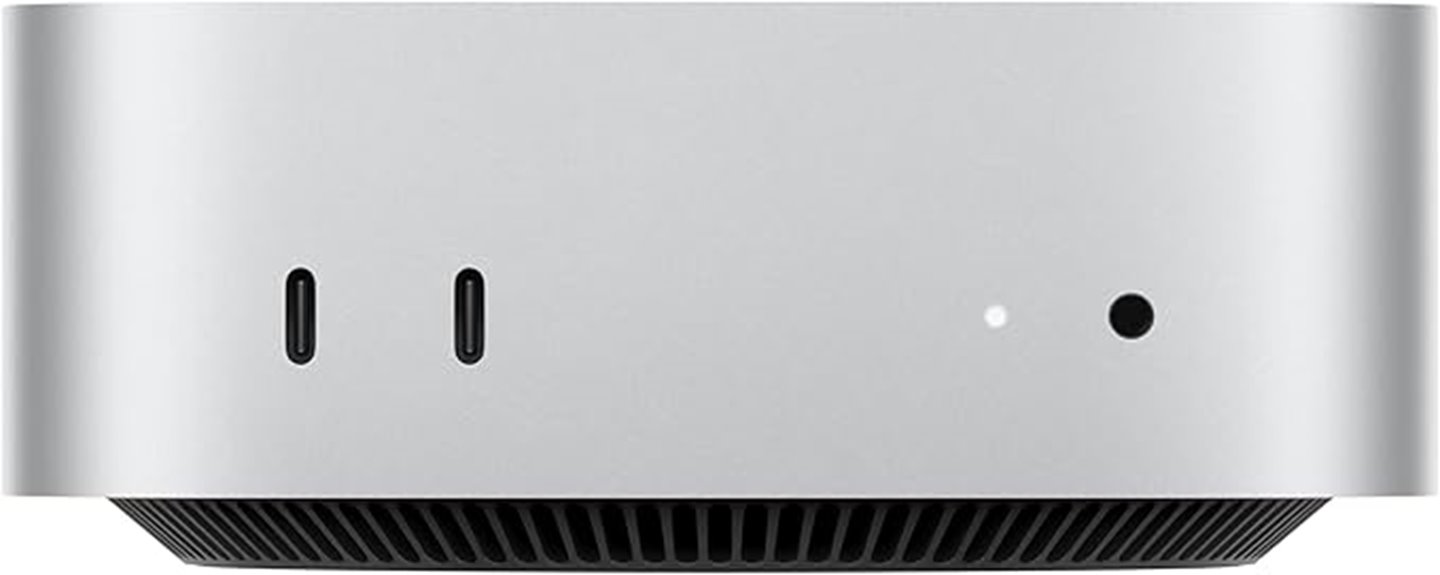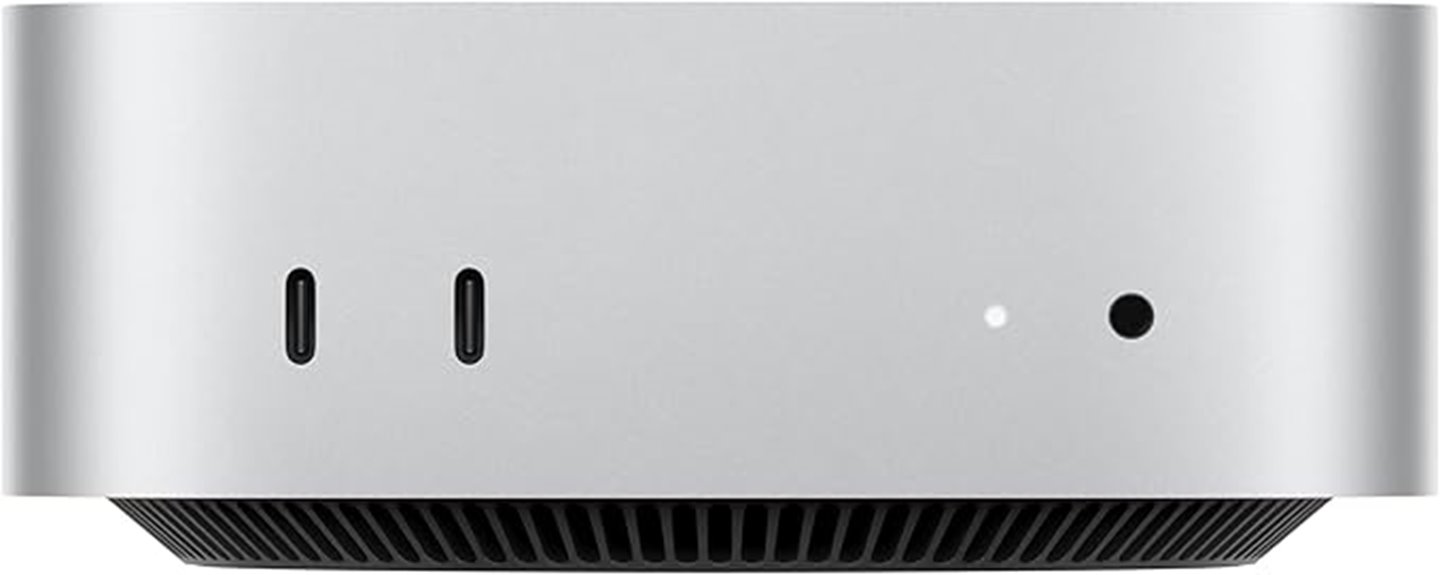If you’re a power user aiming for top-tier performance in 2025, four Mac Studio models stand out with 128GB or more of unified memory. These include configurations with Apple’s latest M3 Ultra or M4 chips, designed for heavy multitasking, 3D rendering, and large-scale workflows. I’d recommend considering models with extensive connectivity options and future-proof features. If you want the full breakdown of these top picks, I’ll share more details shortly.
Key Takeaways
- Look for Mac Studio models featuring 128GB or more of soldered unified memory for demanding professional workflows.
- Prioritize configurations that support extensive connectivity options like Thunderbolt 4, HDMI, and Ethernet.
- Choose models with power-efficient Apple Silicon architecture optimized for high memory capacity and intensive tasks.
- Consider physical size and ecosystem integration for seamless workspace setup and device interoperability.
- Ensure software compatibility and future-proof features to maximize performance for power users in 2025.
Apple Mac mini Desktop Computer with M4 Chip (2024)

If you’re looking for a compact yet powerful desktop that seamlessly integrates with your Apple ecosystem, the 2024 Mac mini with the M4 chip is an excellent choice. Its five-by-five-inch design fits easily next to your monitor, making it perfect for tight spaces. Powered by the M4 chip, it offers a 10-core CPU, 10-core GPU, and a 16-core Neural Engine, delivering impressive performance. It supports up to three displays and features fast Wi-Fi 6E and Thunderbolt 4 ports. Plus, it’s carbon neutral, aligning with Apple’s environmental goals. Despite its small size, the Mac mini lives large in productivity, creativity, and connectivity.
Best For: users seeking a compact, high-performance desktop that integrates seamlessly with the Apple ecosystem and supports demanding creative and productivity tasks.
Pros:
- Compact size (5×5 inches) fits easily next to monitors and in tight spaces.
- Powered by the advanced M4 chip with a 10-core CPU and GPU for impressive performance.
- Supports multiple high-resolution displays and offers fast Wi-Fi 6E and Thunderbolt 4 connectivity.
Cons:
- Limited storage options starting at 256GB SSD may require external solutions for larger needs.
- The small form factor might limit upgradeability or expansion options.
- Higher configurations (like 32GB RAM or 2TB storage) come at additional cost.
Apple 2024 Mac mini Desktop Computer with M4 Pro chip

The Apple 2024 Mac mini Desktop Computer with the M4 Pro chip is an ideal choice for professionals who need powerful performance in a compact form factor. Measuring just 5×5 inches and weighing only 1.6 pounds, it fits easily next to monitors or in tight spaces. Equipped with a 12-core M4 Pro CPU, 16-core GPU, and 24GB of unified memory (expandable to 48GB or 64GB), it handles demanding tasks effortlessly. Its connectivity options include Thunderbolt 5, HDMI, and Ethernet. Built for high-speed data transfer and creative workflows, it seamlessly integrates with Apple’s ecosystem and supports multiple high-resolution displays.
Best For: professionals and creatives who need powerful computing in a compact, space-saving desktop that seamlessly integrates with Apple devices and supports demanding workflows.
Pros:
- Compact design fits easily in tight spaces, ideal for minimalist setups
- High-performance M4 Pro chip with 12-core CPU and 16-core GPU handles intensive tasks effortlessly
- Extensive connectivity options including Thunderbolt 5, HDMI, and Ethernet support multiple high-resolution displays
Cons:
- Limited internal expansion options beyond RAM and storage upgrades
- Premium price point may be a barrier for budget-conscious users
- No dedicated GPU options, which might be a concern for high-end gaming or specialized graphics workloads
Apple Mac mini Desktop Computer with M4 Chip (2024)

For creative professionals and power users who need a compact yet highly capable desktop, the Apple Mac mini with M4 chip (2024) stands out as an ideal choice. It packs a 10-core CPU and GPU, along with a 16-core Neural Engine, delivering smooth performance for demanding apps like Adobe Creative Cloud or Microsoft 365. Its small size—just 5×5 inches—fits easily anywhere, with plenty of ports for connectivity, including Thunderbolt 4 and HDMI. With 24GB of unified memory (expandable to 32GB) and fast SSD options up to 2TB, it offers a perfect balance of power and portability for intensive workflows.
Best For: creative professionals and power users seeking a compact, high-performance desktop capable of handling demanding workflows and multi-display setups.
Pros:
- Compact size with a sleek design that easily fits anywhere
- Powerful M4 chip with 10-core CPU and GPU for smooth multitasking and creative applications
- Extensive connectivity options including Thunderbolt 4, HDMI, and multiple USB-C ports
Cons:
- Limited to maximum 32GB RAM, which may not suffice for extreme memory-intensive tasks
- Storage options up to 2TB might require external solutions for very large files
- Premium price point may be a concern for budget-conscious users
Apple 2024 Mac mini Desktop Computer with M4 Chip

Designed for those who need a compact yet powerful desktop, the Apple 2024 Mac mini with M4 chip delivers exceptional performance in a tiny package. Its 5×5-inch size, just 2 inches tall and weighing only 1.5 pounds, makes it perfect for any workspace. Powered by the M4 chip with a 10-core CPU and GPU, plus a 16-core Neural Engine, it handles demanding tasks effortlessly. It supports up to three displays and offers versatile ports, including Thunderbolt 4, HDMI, and Ethernet. Environmentally friendly and seamlessly integrated with Apple’s ecosystem, this Mac mini combines compact design with impressive power and connectivity for power users.
Best For: power users and professionals seeking a compact, high-performance desktop that seamlessly integrates with Apple’s ecosystem.
Pros:
- Ultra-compact size fits easily into any workspace or setup
- Powerful M4 chip with 10-core CPU and GPU delivers excellent performance for demanding tasks
- Supports multiple high-resolution displays and versatile connectivity options
Cons:
- Limited to 16GB of default memory, which may be insufficient for very intensive workflows without upgrades
- Only 512GB SSD storage standard, potentially needing additional external storage for large files
- Premium price point might be a barrier for budget-conscious users
Factors to Consider When Choosing Mac Studio With 128GB+ Unified Memory

When choosing a Mac Studio with 128GB+ memory, I consider factors like upgrade options, your specific performance needs, and software compatibility. It’s also important to look at connectivity options and power efficiency to guarantee the system fits your workflow. By evaluating these points, you can select a model that balances power, expandability, and energy use effectively.
Memory Expansion Options
Since high-memory Mac Studio models have soldered RAM, you can’t add or upgrade memory after purchase. This means that the memory capacity you choose at checkout is final. If you’re a power user handling large datasets, 3D rendering, or intensive video editing, it’s essential to select the maximum memory option upfront. Upgrading isn’t an option later, so carefully assess your current and future needs. Always verify the maximum supported memory for your specific model to avoid underestimating your requirements. This soldered configuration emphasizes the significance of making an informed decision at the time of purchase, as you won’t be able to expand or replace the RAM down the line. Planning ahead ensures your Mac Studio remains capable of handling demanding workflows for years to come.
Performance Needs Analysis
Evaluating your performance needs is essential before choosing a Mac Studio with 128GB or more of unified memory. I consider whether my workload involves intensive multitasking, large file processing, or demanding creative applications that benefit from high memory capacity. For example, tasks like video editing, 3D rendering, or scientific computing often require 128GB or more for ideal performance. I also think about future scalability—higher memory configurations can extend my Mac’s lifespan and versatility. If my workflow involves running multiple high-memory-consuming applications simultaneously, extra memory helps reduce latency and improves efficiency. Ultimately, understanding whether your tasks are data-heavy or resource-intensive will guide you to the right configuration. High memory capacity isn’t just a luxury; it’s a necessity for top-tier performance in demanding professional environments.
Compatibility With Software
Ensuring your software is compatible with a Mac Studio equipped with 128GB or more of unified memory is vital for maximizing performance and stability. I recommend checking that your macOS version supports the latest updates and features, especially for high-memory configurations. Professional applications like Adobe Creative Cloud, Final Cut Pro, or CAD software should be optimized to utilize large amounts of memory efficiently. It’s also essential to verify that your software is compatible with Apple silicon architecture to avoid performance issues or crashes. Additionally, look for updates or patches from developers that address high-memory scenarios, ensuring stability. Be aware that some specialized or legacy software might have limitations or require extra compatibility layers when running on systems with 128GB+ memory.
Connectivity and Ports
When choosing a Mac Studio with 128GB+ of unified memory, it’s crucial to pay attention to the available connectivity options. I look for models with enough Thunderbolt 4 or Thunderbolt 5 ports to support multiple high-speed peripherals and displays at once. Having a variety of ports, including HDMI and USB-C, ensures I can connect different external devices and configure my workspace flexibly. A Gigabit Ethernet port is a must, and I prefer models with options to upgrade to 10Gb Ethernet for faster wired networking. A high-impedance headphone jack is indispensable for professional audio monitoring. Additionally, support for the latest standards like USB 4 and DisplayPort 2.1 guarantees maximum compatibility and future-proofing, making my setup more versatile and reliable.
Power Consumption & Efficiency
As I consider Mac Studio models with 128GB or more of unified memory, it’s important to think about power consumption and efficiency. Larger memory capacities naturally require more energy, but Apple’s advanced power management features in Silicon chips help keep efficiency high. By optimizing how unified memory is used, the system reduces multiple access cycles, saving power. Choosing energy-efficient components and configurations also minimizes the extra power draw from extensive memory pools. Proper system tuning and workload management are essential to maintain this balance, preventing unnecessary energy use. Overall, even with high-memory setups, Apple’s architecture and smart hardware choices enable these models to operate efficiently without sacrificing performance. This makes them suitable for power users who demand both power and energy savings.
Physical Size & Placement
The compact size of Mac Studio with 128GB+ unified memory makes it an ideal choice for those who need powerful performance without sacrificing desk space. With dimensions around 7.7 inches wide and deep, and about 3.7 inches tall, it easily fits alongside monitors or on crowded desks. Weighing under 7 pounds, it offers stability without bulk, making placement flexible within any workspace. Its small footprint allows for versatile positioning—on a dedicated desk, inside a rack, or integrated into multimedia setups. Careful consideration of its size guarantees compatibility with existing furniture and accessories, helping maintain a clean, efficient environment. This compact form factor maximizes workspace efficiency while delivering the high performance power users demand.
Ecosystem Integration Benefits
Choosing a Mac Studio with 128GB+ unified memory offers more than just raw power; it also opens the full potential of Apple’s ecosystem. Seamless file transfers, messages, and calls between your Mac, iPhone, and iPad make workflows smoother. Features like AirDrop and Universal Clipboard let you quickly share or copy content across devices, boosting productivity. Handoff lets you start a task on one device and continue on another without missing a beat. You can mirror displays or share media effortlessly with Apple TV or other screens. This deep hardware and software integration guarantees optimized performance and enhanced security, giving me confidence that my work remains smooth, secure, and interconnected across all my Apple devices. This interconnected experience is a major advantage for power users.
Frequently Asked Questions
Can Mac Studio Models With 128gb+ Unified Memory Run Windows Applications Efficiently?
Yes, Mac Studio models with 128GB+ unified memory can run Windows applications efficiently, especially when paired with virtualization software like Parallels Desktop or VMware Fusion. I’ve found that the high memory capacity guarantees smooth multitasking and handles demanding Windows programs without lag. Plus, the powerful processors and optimized hardware make running Windows applications on macOS seamless, giving me a great experience for work or creative projects.
How Does Increased Memory Impact GPU Performance in Mac Studio?
Sure, cramming more memory into a Mac Studio doesn’t magically boost your GPU’s raw power, but it sure helps it work smarter. Increased memory means smoother multitasking, faster data access, and less bottlenecking during intensive tasks. So, while it’s not a GPU upgrade, having 128GB+ of unified memory lets your graphics card breathe easier, ultimately improving performance in demanding workflows and creative projects.
Are There Any Thermal Management Concerns With High-Memory Mac Studio Models?
Thermal management isn’t a big concern with high-memory Mac Studio models. Apple designs these machines with efficient cooling systems that handle the increased power and heat output well. I haven’t noticed any overheating issues, even during intensive tasks. The system adjusts itself to keep temperatures stable, so you can run demanding applications without worry. Overall, Apple’s engineering ensures high-memory models stay cool and perform reliably.
What Are the Upgrade Options for Memory in Mac Studio After Purchase?
Imagine your Mac Studio as a sleek, powerful engine humming along; unfortunately, its memory isn’t user-upgradable after purchase. I’ve found that Apple designs these machines with fixed RAM, so upgrading means choosing the right configuration upfront. If you need more memory later, your best bet is consulting Apple or an authorized service provider for possible options, but generally, it’s a decision made at the initial buy.
How Does 128gb+ Unified Memory Affect Software Development Workflows on Mac Studio?
Having 128GB+ of unified memory on my Mac Studio markedly boosts my software development workflow. It allows me to run multiple virtual machines, containers, and heavy IDEs simultaneously without slowdowns. Large projects compile faster, and I can handle complex multitasking with ease. This upgrade minimizes lag and maximizes productivity, especially when working on demanding applications or large codebases, making my development process smoother and more efficient.
Conclusion
Honestly, choosing the right Mac Studio with 128GB+ unified memory feels like a lucky find—sometimes, the best options just come together unexpectedly. Whether it’s the compact power of the M4 chip or the Pro’s extra punch, I’ve seen how these models can seamlessly handle my most demanding tasks. If you’re on the hunt for top-tier performance, trust that your perfect match might just surprise you when you least expect it. Happy hunting!








